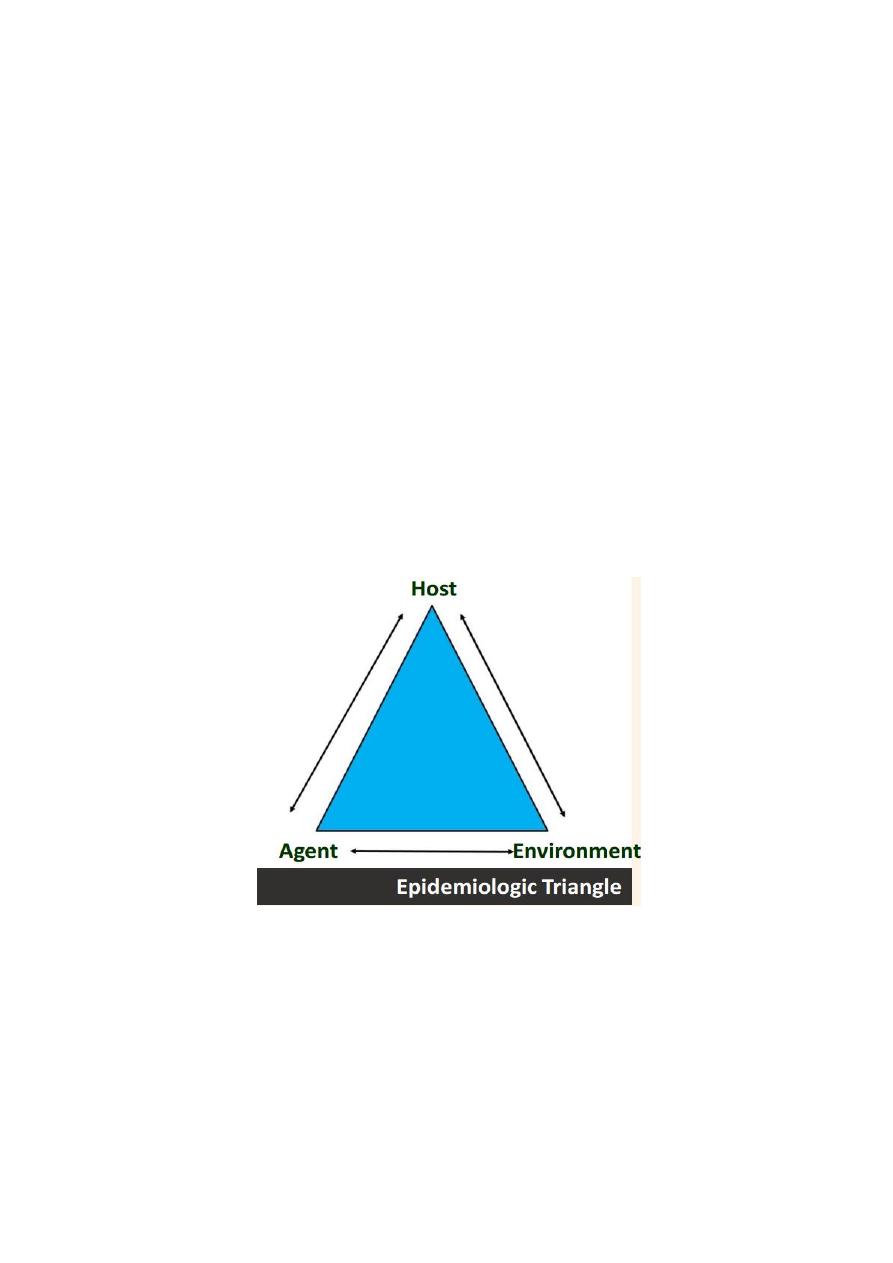
1
Course: Medical Microbiology
Lecturer: Dr. Weam Saad
Subject: Introduction to Medical Microbiology
Introduction to Medical Microbiology
What is microbiology?
Microbiology is the study of Microorganisms (or microbes), microscopic or so
small that they cannot be seen with the naked eye, inhabit every corner of the
globe, some of them are harmful and responsible for many deadly human
diseases and others are useful which form the basis of many industrial processes
and degraded dead bodies help in recycling of essential elements.
Why is microbiology important?
The importance of microbiology in the world today can be showed by the
following list of some of the general areas in which Microbiology is involved:
Medicine
Environmental science
Food and drink production
Fundamental research
Agriculture
Pharmaceutical industry
Genetic engineering.
Important Figures and dates in Microbiology Science:
1. Antoni van Leeuwenhoek started out on his pioneering very simple
microscope work in 1673.
2. The Italian Francesco Redi (1626–1697) showed in an experiment that
the larvae found on meat arose from eggs deposited by flies, and not
spontaneously as a result of the decay process.
3. Edward Jenner, during 1796 discovered a method of smallpox
vaccination after he noted that dairy workers who contracted cowpox
from milking infected cows were resistant to smallpox.
4. Louis Pasteur a French scientist (1822–1895), the most famous figure in
the history of microbiology (father of Microbiology), he used his famous

2
swan-necked flasks to proof that contamination with dust lead to spoilage
of broth (germ theory) and there is no spontaneous generation. He also
used attenuated (weakened) cultures of anthrax and rabies to vaccinate
against those diseases and started the first steps in the science of serology.
He discovered pasteurization the method of sterilization food mainly
dairy products and as preservation method.
5. Joseph Lister is the father of antiseptic surgery, in 1867 he used carbolic
acid for the first time to sterilize instruments during surgeries and reduced
post-operative infections.
6. The German Robert Koch. In 1876 he discovered (Mycobacterium
tuberculosis was the causative agent of tuberculosis, which at the time
was responsible for around one in every seven human deaths in Europe
using simple microscope.
7. Sir Alexander Fleming discovered in 1928 the most common used and
the important antibiotic penicillin from the mold Penicillium notatum .
8. Publication of Watson and Crick’s structure for DNA in 1953 was an
extraordinary achievement that changed the world ever after.
9.
Walter Gilbert and Frederick Sanger developed a method for DNA
sequencing and that helped in production of recombinant DNA and
produce synthetic Insulin in 1979 and first genetic engineered vaccine of
Hepatitis B in 1986.
Classification of Microorganisms:
1. Viruses and prions.
2. Bacteria and Archaebacteria.
3. Fungi, molds and yeasts.
4. Protozoa and helminthes.
Why microorganisms are different?
1. Some of them are cells like bacteria and protozoa (their bodies are cells)
others are not cells like viruses and prions.
2. Some of them are unicellular like bacteria, protozoa and molds. While others
are multicellular like fungi.

3
3. Some of them are prokaryotes like bacteria and others are eukaryotes like
protozoa.
4. Some are able to live free in the environment and others are parasites of other
organisms.
5. Some of them are big microbes like fungi and other are very small microbes
like viruses that cannot be seen only by using electron microscope.
6. Some of them are easy to be cultivated in laboratories on media like Bacteria
while others are intracellular parasites which can grow only inside living cells
like viruses, hens need cell culture or tissue culture.
What is Medical microbiology?
The study of Pathogenic Microorganisms that cause illness to human also
known as clinical microbiology. These illnesses are called infectious diseases
and related to the public health of the populations. This science include studying
of the characteristics of pathogenic microbes, modes of transmission, portals
for entry, virulence factors, pathogenicity, immune system response,
symptoms, diagnosis, laboratory tests, treatment, prevention, epidemiology and
vaccination if found.
The most important goals in studying medical microbiology:
1. Save humanity and improve public health.
2. Control infectious and contagious diseases by diagnosis and treatment
and keep people safe and healthy.
3. Understand infectious diseases etiology to avoid outbreaks and put
emergency management.
4. Prevention and stop spreading infectious diseases causative pathogens.
Terms and Definitions:
Pathology, branch of Biology, refers to the study of diseases and the
abnormalities or
alterations induced by an infection either in structure or
in function causing the clinical
manifestations to appear.

4
Pathogenesis, the events of disease development producing the
pathology.
Pathogenic microorganism is a microbe that can cause pathology.
Disease refers to the existence of pathology, either infectious (resultant
from a pathogenic infection like Cholera), or non-infectious disease
(resultant from physiological defect like Diabetes).
Infection is the damage resultant after successful invasion due to
adhesion and colonization of pathogenic microbe which is not necessary
to ends with infectious disease.
Infectious disease is a disease caused by a pathogenic microorganism
due to its virulence factors.
Contagious disease is a type of infectious diseases that transmits from
infected person to the healthy without need for carrier or vector or special
mode of transmission like blood transfusion.
Virulence is a term referring to the abilities of a microbe to produce
disease in a host, like presence of capsule or production of toxins and
enzymes.
Immunity refers to the degree of resistance of the host agains the
invading microbe.
Etiology refers to the study of disease occurrence, causes, development,
modes of transmission
and prevention.
The host-parasite interaction, the dynamic process of infectious
diseases occurrence when the parasite tries to multiply and the host
defenses try to control.
Epidemiology is the study of diseases and public health conditions in a
defined population and usually needs statistical analysis.
Outbreak is the occurrence of infectious disease in excess of what would
normally be expected in a defined community, geographical area or
season. An outbreak may occur in a restricted geographical area, or may
extend over several countries. It may last for a few days or weeks, or for
several years.
Pandemic is a global disease outbreak spread across a large region
(epidemic occurrence in multiple countries).

5
Endemic
is a disease that is always present in a certain population or
region (regular with continuing occurrence).
Epidemic is an infectious disease that continuously present in a specific
area or geographic location an infectious disease attacks many peoples at
the same time and may spread through one or several communities in a
short period.
Sporadic is a disease that has occasional occurrence.
Epidemiology: Chain of Infection
Infectious diseases result from the interaction of agent, host, and environment,
transmission occurs when the agent leaves its reservoir or host through a portal
of exit, by some mode of transmission, and enters through an appropriate portal
of entry to infect a susceptible host. This sequence is sometimes called the chain
of infection.
Chain of Infection
Source of Agents
Source of infectious agent means where the pathogenic microorganisms came
from, include two sources:
a) Endogenous source: when the microbe is normally found in
human body and form an infection due to suppression of the

6
immune system or using antibiotics for long time that will
imbalance the normal flora like diarrhea caused by E.coli.
b) Exogenous source: pathogenic microbes came from outside human
body and include: patient or carrier people like Typhoid
(Salmonella typhi), animals in zoonosis diseases like Malta fever
(Brucells sp.) and soil like Tetanus (Clostridium tetanus).
Reservoir
The reservoir of an infectious agent is the habitat in which the agent normally
lives, grows, and multiplies then may be transferred to a susceptible host,
(simply, where can I found pathogenic microbes?). Reservoirs include; humans,
animals, and the environment. For example, the reservoir of Clostridium
botulinum is soil, but the source of most botulism infections is improperly
canned food containing C. botulinum spores.
1. Human reservoirs. Patients are common reservoirs of infectious
diseases. Some human reservoirs may or may not show the effects of
illness, which is called a carrier: is a person with inapparent infection
who is capable of transmitting the pathogen to others. Carriers can be:
a) Healthy carriers or Asymptomatic or passive: are those who never
experience symptoms despite being infected; like in the case of gonorrhea
caused by Neisseria gonorrhea, Typhoid caused by Salmonella typhi and
Cholera caused by Vibrio cholera. This type of carriers is considered as
the most dangerous type.
b) Incubatory carriers are those who can transmit the agent during the
incubation period before clinical illness begins; like in the case of
Pertussis.
c) Convalescent carriers are those who have recovered from their illness
but remain capable of transmitting to others; like in the case of Typhoid
and Diphtheria caused by Corynebacterium diphtheria.
d) Chronic carriers are those who continue to harbor a pathogen such as
hepatitis B virus or Salmonella Typhi, the causative agent of typhoid
fever.

7
Note: Carriers commonly transmit disease because they do not realize they are
infected, and consequently take no special precautions to prevent transmission.
While symptomatic persons (patients) who are aware of their illness.
2. Animal reservoirs. The term zoonosis refers to an infectious disease that
is transmissible under natural conditions from vertebrate animals to
humans. Zoonotic diseases include brucellosis (cows and pigs), anthrax
(sheep), plague (rodents), trichinellosis/trichinosis (swine), tularemia
(rabbits), and rabies (bats, raccoons, dogs, and other mammals).
3. Environmental reservoirs. Plants, soil, and water in the environment are
also reservoirs for some infectious agents. Many fungal infections, such
histoplasmosis, their microbes live and multiply in the soil. Outbreaks of
Legionnaires disease are often related to water supplies in cooling towers
and evaporative condensers, reservoirs for the causative organism
Legionella pneumophila.
Portal of exit
Portal of exit is the path by which a pathogen leaves its host. The portal of exit
usually related to the site where the pathogen is localized. For example,
influenza viruses and Mycobacterium tuberculosis exit via the respiratory tract,
schistosomes through urine, cholera vibrios in feces, Sarcoptes scabiei in
scabies skin lesions, and enterovirus 70, a cause of hemorrhagic conjunctivitis,
in conjunctival secretions. Some bloodborne agents can exit by crossing the
placenta from mother to fetus (rubella, syphilis, toxoplasmosis), while others
exit through cuts or needles in the skin (hepatitis B) or blood-sucking
arthropods (malaria).
Modes of transmission
An infectious microbe or agent may be transmitted from its natural reservoir to
a susceptible host in different ways:
1. Direct modes:

8
A. Contact mode; occurs through skin-to-skin contact, kissing, and
sexual intercourse. Direct contact also refers to contact with soil or
vegetation harboring infectious organisms. Gonorrhea is an example.
B. Droplet spread mode refers to spray with relatively large, short-range
aerosols produced by sneezing, coughing, or even talking. Droplet
spread is classified as direct because transmission is by direct spray
over a few feet, before the droplets fall to the ground. Pertussis and
meningococcal infection are examples of diseases transmitted from an
infectious patient to a susceptible host by droplet spread.
2. Indirect modes of transmission
Refers to the transfer of an infectious agent from a reservoir to a host by
suspended air particles, objects (vehicles), or vectors.
A. Airborne transmission occurs when infectious agents are carried by
dust or droplet nuclei suspended in air. Airborne dust includes material
that has settled on surfaces and become re-suspended by air currents
as well as infectious particles blown from the soil by the wind. Droplet
nuclei are dried residue of less than 5 microns in size. Measles, for
example, has occurred in children who came into a physician’s office
after a child with measles had left, because the measles virus remained
suspended in the air.
B. Vehicles that may indirectly transmit an infectious agent include food,
water, biologic products (blood), and fomites (e.g. handkerchiefs,
bedding, or surgical scalpels).
C. Vectors or carrier such as mosquitoes, fleas, and ticks may carry an
infectious agent either mechanical means or biological means.
3. Multiple mode of transmission: when the pathogen is able to use more
than one mode of transmission like HIV virus that cause AIDS.
Portal of entry
The portal of entry refers to the manner in which a pathogen enters a susceptible
host. The portal of entry must provide access to target tissues in which the
pathogen can attach, multiply or their toxins can act. Some infectious agents

9
use the same portal to enter a new host that they used to exit the source host.
For example, influenza virus exits the respiratory tract of the source host and
enters the respiratory tract of the new host. In contrast, many pathogens that
cause gastroenteritis usually called (fecal-oral) route because they exit the
source host in feces and enter a new host through the mouth. Human portals
include:
1. Mouth; Ingestion; by contaminated food or drinks with foodborne
or waterborne microbes, e.g. all gastrointestinal GTI infections.
2. Nose; Inhalation; by ventilation of contaminated air with
pathogenic airborne microbes e.g. TB, Influenza and measles.
3. Mucous membranes, adhesion e.g. Hemorrhagic Enteritis of
E.coli. and syphilis.
4. Contact; either direct contact; inoculation; occur by scratch skin or
trauma, e.g. pox virus and MRSA Staphylococcus aureus.Or by
indirect contact via the vectors:
A. Biological vectors when the vector transmit pathogenic
microbe while the microbe complete its life cycle inside vector,
e.g. the causative agent of malaria undergoes maturation in the
intermediate host (mosquito) before it can be transmitted to
humans.
B. Mechanical vectors when the insects or other animals transmit
microbes by contact like transmission of Escherichia coli and
Shigella sp. by fly and fleas carrying Yersinia pestis. Here the
presence of Mechanical vectors is not of important for parasite
transmission and it can spread by another mode.
5. Anal Transmission, rectal, via entering anus, e.g. Enterobius sp.
6. Vaginal Transmission, venereal diseases or VD, STDs, via
entering Urogenital Tract (UGT) or vagina, e.g. Neisseria
gonorrhea and Trichomonas vaginalis.
7. Placental and colostral Transmission, e.g. AIDS, brucellosis and
Toxoplasma gondii.
8. Blood, during blood transfusion process e.g. hepatitis B, human
immunodeficiency virus AIDS.
Host
The final link in the chain of infection is a susceptible host. Susceptibility of a
host depends on:

10
A. The genetic factors. An individual’s genetics may either increase or
decrease susceptibility. For example, persons with sickle cell anemia
are partially protected from a type of malaria.
B. Nonspecific factors that affect an individual’s ability to resist
infection or to limit pathogenicity of microbes. Nonspecific factors
(Innate Immunity) that defend against infection include the skin,
mucous membranes, gastric acidity, cilia in the respiratory tract, the
cough reflex, and other nonspecific immune response. Factors that
may increase susceptibility to infection by disrupting host defenses
include malnutrition, alcoholism, and disease or therapy that impairs
the nonspecific immune response.
C. Specific Immunity. Refers to protective antibodies that are directed
against a specific microbe. These specific antibodies may develop in
response to infection, vaccine, or toxoid or may be acquired by
transplacental transfer from mother to fetus or by injection of
antitoxin or immune globulin.
Control strategies of Infectious Diseases:
Knowledge of the portals of exit and entry and modes of transmission provides
the bases for determining appropriate control measures. Control measures are
directed at the following levels:
1. At the level of infectious agent source (reservoir)
Refers to the treatment of infected patients with antibiotics and other therapies
to eliminate the infection, soil may be decontaminated or covered to prevent
escape of the agent.
2. At the level of mode of transmission.
This level includes many strategies depending on the pathogenic microbes’
mode of transmission. In general; control the direct transmission may be
accomplished by isolation of infected patients. Vehicle borne transmission may
be stopped by decontamination of the vehicle. To prevent fecal-oral
transmission, efforts focus on improve hygiene and handwashing. For airborne
diseases, strategies may be directed at modifying ventilation and filtering the
air. In the case of vector borne transmission, measures may be directed toward

11
controlling the vector population, such as spraying to reduce the mosquito
population.
3. At the level of entry portals
Some strategies that protect portals of entry are simple and effective. For
example, bed nets are used to protect sleeping persons from being bitten by
mosquitoes that may transmit malaria. Wearing personal protecting Equipment
PPE is an important issue for workers in medical field, e.g. a dentist’s mask and
gloves are used to protect the dentist from a patient’s blood, secretions, and
droplets, as well to protect the patient from the dentist.
4. At the level of host
Control via increase the host’s defenses. Vaccinations promote development of
specific antibodies that protect against infection e.g. DPT and BCG vaccines.
On the other hand, prophylactic medications usually used when visiting
endemic area with certain infectious diseases e.g. use of antimalarial drugs,
recommended for visitors to malaria-endemic areas.
